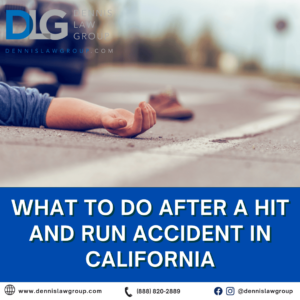
A hit-and-run accident can leave anyone rattled in its immediate aftermath. Beyond the physical injuries and emotional trauma, there is a flurry of legal and formal necessities to handle. According to the AAA Foundation for Traffic Safety, over 11% of all police-reported crashes in the U.S. are classified as hit-and-run. Hence, it is vital to know these unfortunate occurrences. Here is a guided roadmap on what to do after a hit-and-run accident in California.
Understanding Hit-and-Run Accidents
A hit-and-run accident refers to a scenario in which a driver involved in an auto accident chooses to flee from the scene without stopping to identify themselves or offer assistance to injured parties. California law takes such offenses seriously and has put in place stringent procedures and penalties for those who consider hitting and running.
Immediate Steps to Take After a Hit-and-Run Accident
- Ensure your Safety: If you are physically capable, move to a safe place away from traffic.
- Report to Law Enforcement: Notify local police about the incident. Provide them with as much information as possible. As the official document of the event, a police report plays a crucial role in the claim process.
- Collect Evidence: Even though the defendant fled, your surroundings could provide important details about the accident. Make a note of the time and location, look for witnesses, and take photographs of the site and damages.
Legal Processes After a Hit-and-Run Accident in California
In California, the law requires accident victims to report hit-and-run accidents to your insurance company, even if you were not at fault. This report should include:
- Details of the incident
- Photographs from the accident scene
- The police report
Perpetrators of hit-and-runs may face hefty fines, imprisonment, or both, depending on the severity of the accident. As the victim, you will likely require an experienced attorney’s assistance in securing due compensation if the offender is caught.
Managing Damages and Insurance
Generally speaking, hit-and-run victims can apply for compensation under Uninsured Motorist Coverage (UMC). If you have UMC, it can cover:
- Medical bills
- Car repair expenses
- Rental cars
Filing a claim involves providing your insurer with all the gathered evidence, the police report, and details about the losses incurred. They will then evaluate the claim and determine the payout. A skilled accident attorney will ensure that the insurance company provides you with the financial compensation you deserve.
Preventive Measures to Minimize Impact
Here are some tips in case you are ever involved in a hit and run:
- Always have on hand your emergency contact numbers and first aid kit.
- Keep your driver’s license, registration, and other papers up-to-date and accessible.
- Opt for comprehensive auto insurance, that includes UMC.
Conclusion
Hit-and-run incidents on California’s crowded roads necessitate knowing the proper steps to take afterward. Ensuring safety, reporting to law enforcement, and collecting evidence are crucial initial actions. Being prepared and informed helps in navigating the claim process, which may involve consulting with an attorney and understanding your uninsured motorist coverage. Having a comprehensive insurance policy and maintaining a ready-to-go first aid kit in your car are essential preventive measures against the repercussions of such accidents.
Despite the unpredictability of life, knowing how to respond to a hit-and-run can provide a sense of control and protection. It’s vital to prioritize safety, gather as much information as possible, and utilize California’s legal framework to safeguard your rights. Engaging an attorney and consulting with your insurance provider can help mitigate the financial impact. Preparedness and vigilance are key to ensuring your interests are protected on the bustling roads of California.
To discuss your hit and run accident claim, contact the skilled accident attorneys at Dennis Law Group today.
